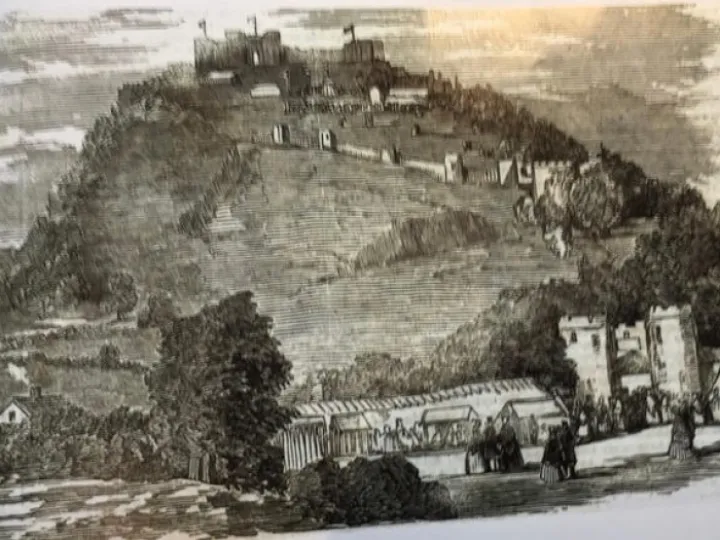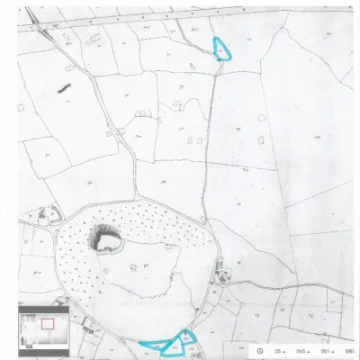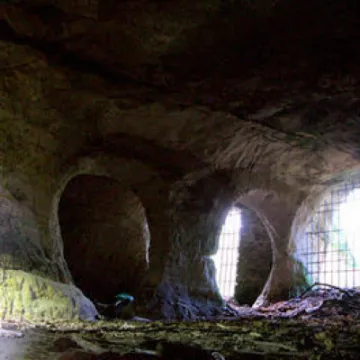The Beresfords of Beeston - Early Victorian Sand-Merchants
The English Heritage Guidebook to Beeston Castle (2007,p.17) refers to the caves in the outer ward as having been known in the C19th as 'Beresford's Caves' ... "supposedly named after a local inhabitant who made a living from quarrying sandstone. The stone was so soft that it could be easily crushed and the resulting sand was used as an early form of industrial sandblasting (1) for cleaning the hulls of canal boats".
The canal that passes Beeston was originally the Chester Canal, opened in 1779 to link the river Dee with Nantwich. There was a staircase of locks at Beeston. This was closed in 1787 when the staircase collapsed but it reopened in 1790 and began to flourish from 1805 when other branches were linked with it to eventually become the Shropshire Union Canal.
There is a record of Beresfords in Beeston in the earliest English Census of 1841. A George Beresford (65) and wife Elizabeth (nee Dodd, 60) were living with a daughter Elizabeth (16) at an unnamed address there.
In the Census, George is described as an "Agricultural Worker" but the Tithe Apportionments, five years later in 1846, show him occupying four plots of land, around Beeston Castle: Plot Nos: 182, 183, 184 and 84. The first three of these were clustered around the lane along the southern boundary of the castle where the Sandstone Trail now runs.
- Plot No.184 was called Sandhole Croft and it appears to have been directly above the present cave but outside the perimeter wall. None of the four plots is attributed with the production of sand – all are cultivated for arable or mowing purposes and Beresford is described as a Farmer.
- Plot No.182 had a cottage and garden where, presumably, the Beresfords lived, and an engraving from the Illustrated London News of 1851, reprinted in the English Heritage Guidebook, 2007 (pp34-5), shows (bottom left) the roof and chimney of a small house in that location now the site of the present Castle café. It can also be seen on the earliest OS map for 1875.
See Photo 1: Beeston in 1851 as depicted in the Illustrated London News
George had been born in 1772 when the Beeston Estate had been owned by the Mostyn family for a century. The castle and its grounds were fairly run-down although their picturesque, crumbling condition was already a tourist attraction. Sand excavation for domestic purposes may have been a profitable side-line from some time before, but George's early years coincided with the rise of canal-building and the family's proximity to
the Chester Canal would have enabled him to profit from the opportunities that offered, both in terms of the transport of sand and the servicing of the boats.
Plot 84 is a curious little field to the north, beside a lane (now the route of the Sandstone Trail) leading down to Wharton's Lock. It is described as a "Croft" for mowing, but did George use this as some kind of stockyard close to the canal? At the time of the tithe map, however, there was an ominous new feature crossing between this field and the lock: the embankment for Robert Stephenson's new Chester and Crewe Railway line which was
opened in 1840. The railways eventually spelt the end of the boom in narrow-boat business.
See Photo 2: Tithe map of 1846 showing the Beresfords' plots and the railway line.
The canal is just off the map to the north of this.
It can be supposed that much of the mining of the Beeston caves would have been conducted during George's working years: from the 1780s to his death in 1849. Two more events during this period are worth recording: in 1827 The Cheshire Chronicle recorded a fatal accident to a worker, Samuel Murrey... "killed in a Sandhole. The deceased was at work ... at the foot of Beeston Castle, and picking out the sand when a quantity of it fell upon him from the side of the hole and nearly buried him, whereby both his legs were broken, and he was otherwise so severely crushed that he died in the afternoon of the same day".
Such events were common in this dangerous industry but it is not recorded whether they would have given much pause to the managers of the business.
Another event, coincidental with the opening of the railway, that would have been of real significance to the Beresfords, was the purchase of the Beeston Estate from the Mostyn family by John Tollemache in 1840.
Tollemache undertook extensive work on restoring and improving the Castle, and in 1846 he built the present gatehouse and the stone wall surrounding the outer ward. This may have meant that Beresford would have needed to negotiate permission to continue mining, as the present cave entrance is inside the perimeter wall. There is a filled-in gateway in the wall close to the cave but there is also a possibility that there was access through the roof of the cave directly from the field above.
It is not clear whether the family continued to mine the cave after George's death. He and Elizabeth had five surviving children: Samuel (b.1809), Mary (b.1815), George (b.1818), Thomas (b.1822) and Elizabeth (b.1825). By 1841 all but Elizabeth had seemingly left the home in Beeston, but in the Census of 1851, young George (32) is back there living with his widowed mother. His occupation is given as "Labourer", but it is possible that he continued the family mining business for a while. His sister Elizabeth was now married to Sampson Brooks, a "Stone Master" living nearby in Bunbury Heath.
Meanwhile, an older brother, Samuel (32) had been living in Woodworth Green a hamlet to the east of Bunbury. He is also described in the Census as an "Agricultural Labourer", but by 1851 he had moved to Alpraham and his occupation was given as "Grocer" and "Uxter" (a form of the word "huckster", meaning a peddler). He remained in Alpraham and, in 1861, was described as a "Higler" (also meaning peddler), with a son, John, taking on the role of grocer.
George married in 1857 and in 1861 he was now head of a growing family and living, like his brother Samuel before, at Woodworth Green. His occupation is also given as "Higgler". By 1871 he and his expanding family had followed Samuel to Alpraham, and George's occupation is given as Farmer. In 1881, still in Alpraham, his occupation is given as Butcher and Farmer.
He died on 6th November 1884 and left a will leaving his property to his ten children. The occupational and residential trajectories of Samuel and George suggest that they shared moderately successful, upwardly mobile careers(2). The terms "Uxter" and "Higgler" suggest that they undertook itinerant peddling of some kind as a side-line to farming, butchery and grocery. This would be consistent with selling sand.
Today the caves are an impressive testimony to the work of the Beresford family and the miners who preceded them. The caves are caged and are a protected home for several species of bats.
Photo 3: the interior of the caves today
There is more to be learnt about the Beresfords.
- For how long were they excavating the cave?
- What was their relationship with the Mostyn/Tollemache Estate(3)?
- How exactly did they operate the cleaning of the canal-boat hulls?
The Trust would welcome any information that can help to fill out this picture of a forgotten industry that at one time must have played an important part in the economy of the Sandstone Ridge.
Peter Winn
Many thanks to volunteer, Mary Jones, for her research work on this.
Click on each image to enlarge.
Sources of Information:
(1) The term for scraping the hull side of a vessel was "graving". It was always done to wood constructed vessels, because anything more invasive would have damaged the hulls. It wasn't until the very late 1800s that metal constructed vessels started appearing on the inland waterways and they were not a common sight until the 1920s-1930s. The Beresfords' technique of graving may have been better described as "wetblasting" where sand is mixed with water to be fired out of a high-pressure nozzle but what equipment might have been available to the Beresfords to achieve this is not recorded. Thanks to Alexander de Leie of the Canal & River Trust for this information.
(2) A younger brother, Thomas, who had been born in Beeston in 1822, is of less certain history. The only census record that seems to fit is from Hartlebury in Worcestershire in 1861 where a Thomas of the right age and birthplace is recorded as a Master Mason's Labourer.
(3) The Tollemache papers are deposited in the Cheshire Archives and Local Studies. The Mostyn papers are spread around several sites in Wales but some are also in the Cheshire Archives. More about the Estate's dealings with the Beresfords may be gleaned from these when accessible.

Sandstone Ridge Trust
Registered Company No. 7673603
Registered Charity No. 1144470
info@sandstoneridge.org.uk



